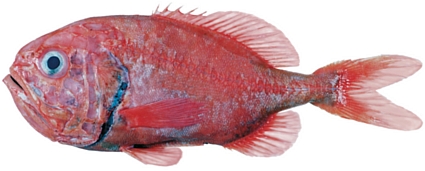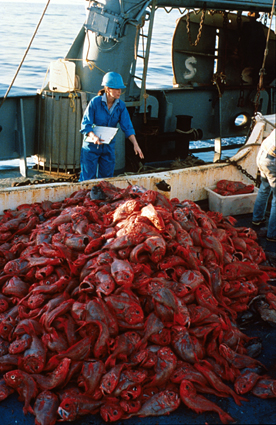
Common name: Orange Roughy. Scientific name: Hoplostethus atlanticus. Family: Trachichthyidae
Orange Roughy: Can’t believe it has taken FFT over a year to come to this important fish of the sea. Mind you, I still use a typewriter and a Teledex.
Anyway, they are also know as the slimehead or deep sea perch and, as the last name suggests, are found in deep waters between 180m and about 1800m. They are found around Australia and New Zealand, in the Western Pacific Ocean, Atlantic Ocean, and in the Eastern Pacific off Chile.

Inspecting a trawl of orange roughy. Orange roughy is a popular foodfish with a good export market, particularly to the United States. Orange roughy stocks on the southern boundary of the Australian Fishing Zone (South Tasman Rise) are considered vulnerable to exploitation as the species is long-living and easily caught when aggregating to spawn or feed. Sustainable catch rates elsewhere in the Australian Fishing Zone are a matter of continuing scientific assessment. CSIRO Marine Research contributes to this through the interpretation of acoustic survey data and biological information collected using the fisheries research vessel Southern Surveyor.
The orange roughy is slow growing and long lived – usually about 145 year but apparently there is one in the Australian National Fish Collection in Hobart that is about 160 years old.
The orange roughy grows to about 75cm and a maximum weight of 7kg.
Because it is so slow growing and late to mature, the species is extremely susceptible to overfishing and stocks especially those off New Zealand and Australia collapsed in the 1980s and there is debate if they have recovered.
The information below is from Wikipedia and I think is another reason (to go along with the fact the fish have had a bloody hard time over the years) to exclude them from your diet.
Due to its longevity, the Orange Roughy accumulates large amounts of mercury in its tissues, having a range of 0.30 – 0.86 ppm compared with an average mercury level of 0.086 ppm for other edible fish. Based on average consumption and the recommendations of a National Marine Fisheries Service study, in 1976, the FDA set the maximum safe mercury level for fish at 1 ppm. Regular consumption of Orange Roughy can have adverse effects on health.


30th November 2012 at 5:47 pm
At last! The orange roughy! Btw, I know someone who could upgrade you to an IBM Selectric….
Sent from my iPad
30th November 2012 at 2:54 pm
I am very much interested in the issue of Hg in fish despite myself as I have now accumulated in my practice three fishng guides who had toxic levels of mercury in their blood. When I first found the index case he was a guide on the English Wabigoon River systems in North Western Ontario. This river system became notorious as the prime case of Minamata disease a neurological condition due to methyl mercury confused by Canadian MDs with late stages of alcoholism esp. cerebellar ataxia.. So I considered it to be a localised phenomenon due to either mining activities of heavy metals or pulp and paper processing or even due to acid rain dissolving granite bedrock in spring runoff. Only Japanese scientists who worked with Minamata diease found the correct answer as they recognised it immediately.
Then to my surprise another fishing guide from North Eastern Ontario working on Wabinakagami Lake had the similar high levels. Neither did though have any neurological signs or symptoms of Minamata disease. After a few months both had their Hg levels return to acceptable levels.
Finally a fishing guide right in Sault Ste Marie between Lake Superior and Lake Huron also had elevated levels of Hg. But no avid fisherman had any abnormal values.
So this must be a general condition not local if bodies of water 500 to 1000km distant have the same effect.
One further speculation was that it is the economic resurgence of China which is the culprit burning dirty coal with no scrubbing or processing which releases Hg into the atmosphere
of the Northern Hemisphere.
But now this Australian and New Zealand waters as well as Canadian, ergo it must be a global phenomenon.
It could be of course natural but the culprit may be human activity. Acid rain comes mainly from Texan agricultural practices not just Canadian mining and pulp and paper or Chinese coal burning.
Then there is Cd in moose and dear livers discovered first in Sweden but Canadian provinces and US states have confused and confusing responses.
Moose and deer and walleye and whitefish and herring and pike but not the salmonidae all are then contaminated by heavy metals even though they dont live a 150 years but less than 15 as these australasian deep water fish.
30th November 2012 at 8:20 pm
It’s a cute fish, huh?
30th November 2012 at 1:54 pm
They have particularly intriguing otoliths.